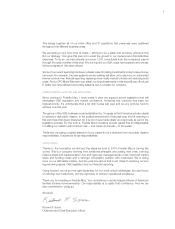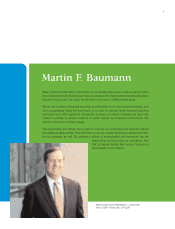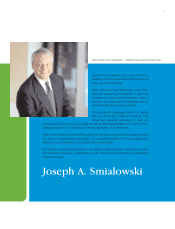Freddie Mac 2004 Annual Report Download - page 15
Download and view the complete annual report
Please find page 15 of the 2004 Freddie Mac annual report below. You can navigate through the pages in the report by either clicking on the pages listed below, or by using the keyword search tool below to find specific information within the annual report.BUSINESS
Overview
Freddie Mac is a stockholder-owned Ñnancial services company chartered by Congress on July 24, 1970
under the Federal Home Loan Mortgage Corporation Act, as amended, which we refer to as the Freddie Mac
Act or our charter. At December 31, 2004, we had total assets of $795.3 billion, total liabilities and minority
interests of $763.9 billion, and total stockholders' equity of $31.4 billion. At May 13, 2005, we had 5,064 full-
time and 153 part-time employees. Our principal oÇces are located in McLean, Virginia. We have additional
oÇces in Washington, D.C.; Reston, Virginia; Atlanta, Georgia; Chicago, Illinois; Dallas, Texas; New York,
New York; and Woodland Hills, California.
We fulÑll the requirements of our charter by purchasing residential mortgage loans and mortgage-related
securities from mortgage lenders and securities dealers and by providing our credit guarantee of payment of
principal and interest for residential mortgages originated by mortgage lenders. Through our credit guarantee
activities, we securitize mortgage loans by issuing undivided interests in pools of purchased mortgages, which
are called Mortgage Participation CertiÑcates, or PCs, to third-party investors. We also resecuritize mortgage-
related securities that are issued by us or the Government National Mortgage Association, or Ginnie Mae, as
well as non-agency entities. Securities issued through our resecuritization activities are referred to as
Structured Securities. For further information concerning our mortgage purchase and securities issuance
activity and the composition of our Retained portfolio, see ""MD&A Ì OUR RETAINED AND TOTAL
MORTGAGE PORTFOLIOS'' and ""MD&A Ì VOLUME STATISTICS.''
For more than three decades, we have been one of the largest participants in the U.S. residential
mortgage market. The residential mortgage market consists of a primary mortgage market that links
homebuyers and lenders and a secondary mortgage market that links lenders and investors. We purchase
mortgage loans that Ñnance homes in every geographic region of the U.S., including U.S. territories (Puerto
Rico, Guam, U.S. Virgin Islands). By providing liquidity and eÇciency in the secondary mortgage market, we
reduce the cost of homeownership and rental housing and improve the quality of life by making the American
dream of access to a decent and aÅordable home possible.
In the primary market, residential mortgage lenders originate or provide mortgages to homebuyers. These
lenders include mortgage banking companies, commercial banks, savings banks, savings and loan associations,
credit unions and state and local housing Ñnance agencies. Lenders may choose to replenish their supply of
lending capital by selling the mortgage loans they originate into the secondary mortgage market.
We compete in the secondary mortgage market with the Federal National Mortgage Association, or
Fannie Mae, and other Ñnancial institutions that retain or securitize mortgages, such as banks, dealers and
thrift institutions, and the Federal Home Loan Banks. We compete, primarily on the basis of price, products,
structure and service, by buying and selling mortgages in the form of whole loans (i.e., mortgage loans that
have not been securitized) and mortgage-related securities. We also compete for low-cost debt funding with
Fannie Mae, the Federal Home Loan Banks and other institutions that hold mortgage portfolios. Competition
from these entities can vary with economic, Ñnancial market and regulatory environments.
We compete in the large and growing mortgage debt market. Total U.S. residential mortgage debt was
$8.7 trillion as of December 31, 2004, according to reports from the Federal Reserve System. In relation to
this market, our Total mortgage portfolio was $1.5 trillion as of December 31, 2004. See further discussion of
our mortgage portfolio holdings in ""MD&A Ì OUR RETAINED AND TOTAL MORTGAGE PORTFO-
LIOS.'' Total residential mortgage debt outstanding in the U.S. grew at an annual rate of 13 percent in both
2003 and 2004. We expect economic and demographic trends will continue to increase the total amount of
mortgage debt outstanding, though at a slower rate than in the past few years. The share of the mortgage debt
market attributed to Fannie Mae and us, however, has declined recently due to the increasing proportion of
adjustable rate mortgages, or ARMs, and other non-traditional mortgage products originated. Banks have
tended to retain these mortgages rather than sell them to the GSEs. In addition, there has been strong demand
for mortgages in general by other investors, particularly banks.
Freddie Mac
3
























